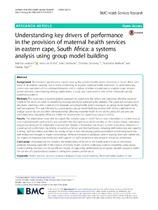| dc.contributor.author | Lembani, Martina | |
| dc.contributor.author | de Pinho, Helen | |
| dc.contributor.author | Delobelle, Peter | |
| dc.date.accessioned | 2021-09-02T12:28:04Z | |
| dc.date.available | 2021-09-02T12:28:04Z | |
| dc.date.issued | 2018 | |
| dc.identifier.citation | Lembani, M., de Pinho, H. et al. (2018). Understanding key drivers of performance in the provision of maternal health services in eastern cape, South Africa: a systems analysis using group model building. BMC Health Services Research, 18(1). https://doi.org/10.1186/s12913-018-3726-1 | en_US |
| dc.identifier.uri | https://doi.org/10.1186/s12913-018-3726-1 | |
| dc.identifier.uri | http://hdl.handle.net/10566/6599 | |
| dc.description.abstract | Background: The Eastern Cape Province reports among the poorest health service indicators in South Africa with
some of its districts standing out as worst performing as regards maternal health indicators. To understand key
drivers and outcomes of this underperformance and to explore whether a participatory analysis could deepen
action-oriented understanding among stakeholders, a study was conducted in one of the chronically poorly
performing districts.
Methods: The study used a systems analysis approach to understand the drivers and outcomes affecting maternal
health in the district in order to identify key leverage points for addressing the situation. The approach included semistructured interviews with a total of 24 individuals consisting health system managers at various levels, health facility
staff and patients. This was followed by a participatory group model building exercise with 23 key stakeholders to
analyze system factors and their interrelationships affecting maternal health in the district using rich pictures and
interrelationship diagraphs (IRDs) and finally the development of causal loop diagrams (CLDs).
Results: The stakeholders were able to unpack the complex ways in which factors were interrelated in contributing to
poor maternal health performance and identified the feedback loops which resulted in the situation being intractable,
suggesting strategies for sustainable improvement. Quality of leadership was shown to have a pervasive influence on
overall system performance by linking to numerous factors and feedback loops, including staff motivation and capacity
building. Staff motivation was linked to quality of care in turn influencing patient attendance and feeding back into
staff motivation through its impact on workload. Without attention to workload, patient waiting times and satisfaction,
the impact of improved leadership and staff support on staff competence and attitudes would be diminished.
Conclusion: Understanding the complex interrelationships of factors in the health system is key to identifying
workable solutions especially in the context of chronic health systems challenges. Systems modelling using group
model building methods can be an efficient means of supporting stakeholders to recognize valuable resources within
the context of a dysfunctional system to strengthen systems performance. | en_US |
| dc.language.iso | en | en_US |
| dc.publisher | BMC | en_US |
| dc.subject | Health systems | en_US |
| dc.subject | Systems dynamics Analysis | en_US |
| dc.subject | Group model building | en_US |
| dc.subject | Maternal health | en_US |
| dc.subject | Quality of care | en_US |
| dc.title | Understanding key drivers of performance in the provision of maternal health services in eastern cape, South Africa: a systems analysis using group model building | en_US |
| dc.type | Article | en_US |

